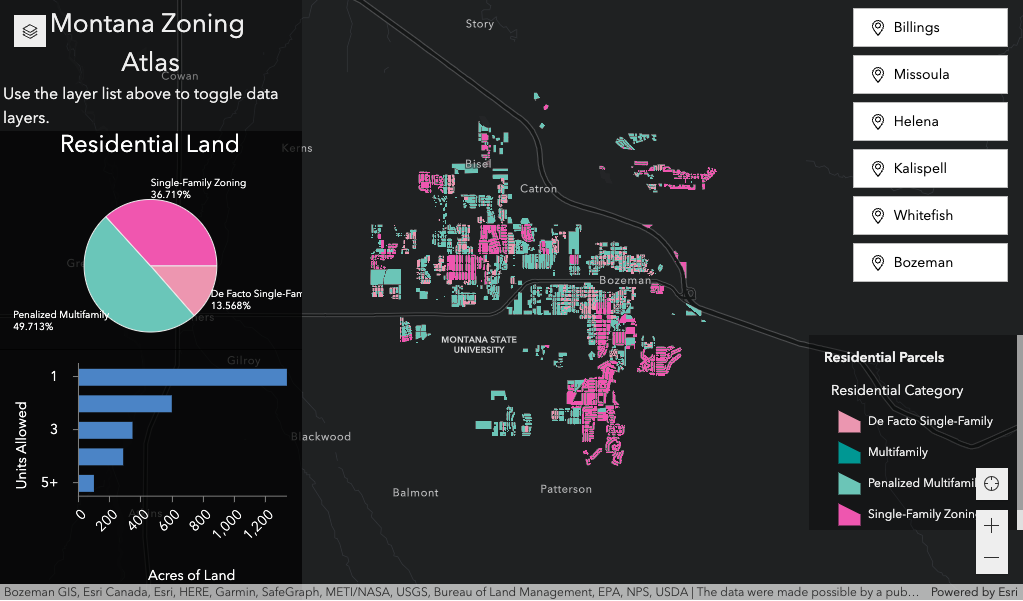Introduction: Montana’s Housing Shortage
Montana’s affordable housing crisis is fundamentally driven by a shortage of available homes.
From 2010-2020 Montana’s population grew 10% while housing only increased 7% — contributing to sky-high home prices.
So why isn’t the market keeping up with demand for affordable housing?
The research consensus is clear that the plethora of zoning regulations commonly imposed by local governments play a significant role in limiting market supply and driving up the costs of housing:
- A 2021 report by Pew Charitable Trusts to the Montana Legislature found jurisdictions that heavily regulate their housing supply see higher housing costs, slower economic growth and fewer homes built.
- A 2021 study from the National Association of Homebuilders estimated that excessive regulations add as much as $93,000 to the average price of building a single-family home.
- In a 2019 article in Montana Business Quarterly, the Director of the Bureau of Business and Economic Research (BBER) at the University of Montana said “there exists ample evidence that local regulation has a significant impact on housing costs.”
There is also an emerging political consensus around the effects of local government zoning regulations on the cost of housing:
- President Barack Obama developed a toolkit in 2016 which said that “local policies acting as barriers to housing supply include land use restrictions that make developable land much more costly than it is inherently.”
- In a 2019 executive order, President Donald Trump called zoning regulations “the leading factor in the growth of housing prices.”
- In a 2021 veto letter, Montana Gov. Greg Gianforte said “the most effective way to address housing affordability challenges is to reduce the panoply of regulations faced by housing development.”
- In a 2021 Fact Sheet President Joe Biden’s administration said “for decades, exclusionary zoning laws – like minimum lot sizes, mandatory parking requirements, and prohibitions on multifamily housing – have inflated housing and construction costs and locked families out of areas with more opportunities.”
Two types of exclusionary zoning regulations have an outsized impact on housing affordability when combined: Single-Family Zoning and Minimum Lot Areas.
Single-Family Zoning
Cities in Montana use zoning to tell us what kind of houses can be built and where.
When certain kinds of homes are “permitted” in a given zone, home builders have a right to build that type of home as long as they meet all the other zoning requirements. This is also referred to as “by-right” zoning.
Conventional single-family homes are the most expensive types of homes to build. By contrast, two, three and four family home types are more affordable by design. Small, multi-family housing such as duplexes, townhomes or triplexes can deliver multiple units on the same size lot as a traditional single-family home, making them less expensive to build. Multi-family home types can be more affordable options for low or middle income residents like renters and young families.
Exclusionary zoning practices restrict the types of homes permitted “by-right” in a particular neighborhood, often separating single-family homes from multi-family homes.
Exclusionary Single-Family Zoning can either outright prohibit multi-family homes or it can penalize multi-family housing by conditioning approval on public hearings, special requirements or a long and costly discretionary permit process.
In effect, Exclusionary Single-Family Zoning tells residents who can’t afford traditional single-family homes they aren’t welcome in certain neighborhoods, often the most desirable and opportunity-rich areas of town.
Researchers say Exclusionary Single-Family Zoning practices lead to more expensive housing and fewer homes being built:
- A 2019 paper published by the Journal of the American Planning Association said that Exclusionary Single-Family Zoning “makes it harder for people to access high-opportunity places, and in expensive regions it contributes to shortages of housing, thereby benefiting homeowners at the expense of renters and forcing many housing consumers to spend more on housing.”
- 2021 testimony to the Montana legislature from Senior Research Fellow Emily Hamilton of the Mercatus Center noted “cities and towns across Montana have many rules that limit the quantity and type of homes that can be built, including minimum-lot-size regulations, height limits, and single-family zoning. In part owing to these rules, many residents across the state are suffering from housing costs rising faster than in other states.”
- Bozeman’s 2021 Code Audit called the city’s Exclusionary Single-Family Zoning practices a “significant barrier to producing and preserving affordable housing.”
Minimum Lot Areas
Minimum Lot Areas are another common local government regulation which say that a certain type of home can only be built on a certain size of property within a particular zoning district.
Minimum Lot Areas effectively prohibit multi-family development when the lot size required exceeds the dimensions of the existing lots. This creates “de-facto” Single-Family Zoning.
Minimum Lot Areas can also penalize affordable multi-family homes by requiring larger and more expensive lots for each additional unit added to a building. Additional lot space is often required even if the actual building takes up no more lot space than a single-family home, as observed in modern stacked duplex and triplex designs.
Researchers say that Minimum Lot Area Penalties can have an outsized impact on affordability:
- A 2021 University of Montana BBER report found Minimum Lot Areas “raised housing prices by 7 and 9%, and estimates of the effect over time reach as high as 20%”
- A 2020 Mercatus Center report said minimum area requirements “limit urban development, driving up lot sizes and thereby increasing housing prices.”
- A 2021 Manhattan Institute report found Minimum Lot Area regulation “forces homes to sit on lots larger than what the market might otherwise demand, thereby reducing overall housing production while raising prices for those housing units that are produced.”
In 2019, the City of Helena abolished nearly all Minimum Lot Area Requirements. The Helena Association of Realtors said abolishing Minimum Lot Sizes would “address housing goals by increasing dwelling unit supply while also protecting the character and quality of the city’s neighborhoods.” No one spoke in opposition at the hearing.
Billings also recently moved from Minimum Lot Area requirements to a simpler lot width requirement.
These changes may be one factor keeping average home prices in those cities relatively affordable compared to cities with minimum lot area requirements like Bozeman, Missoula and Kalispell.



